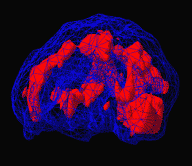EMDR Treatment
If we are seeing an overall decrease of symptoms, it would make sense that there would also be an observable change in the nervous system. On a physiological level we do see evidence of this by brain scans by Daniel Amen, M.D.
Brain Scan - Before EMDR

Brain Scan – After EMDR

Before and after EMDR brain scans. Left photo shows a woman with Post Traumatic Stress Disorder. Right photo shows the same patient after four ninety-minute EMDR sessions. The red areas indicate overactivity in the brain.
— Photos by Dr. Daniel Amen
EMDR Treatment History
EMDR was first developed by Francine Shapiro, noticing that certain eye movements reduced the intensity of disturbing thoughts. Shapiro found when she was experiencing a disturbing thought, her eyes were involuntarily moving rapidly. She also noticed, when she brought her eye movements under voluntary control while thinking a traumatic thought, anxiety was reduced. She then conducted a scientific study in 1989. The success rate of that first study using trauma victims was posted in the Journal of Traumatic Stress. Shapiro soon developed EMDR therapy for Post Traumatic Stress Disorder (PSTD). She speculated that traumatic events “upset the excitatory/inhibitory balance in the brain, causing a pathological change in the neural elements. EMDR is now recommended as an effective treatment for trauma in the Practice Guidelines of the American Psychiatric Association. EMDR also has validation by the American Psychological Association, and the Department of Defense and the Veteran’s Administration.
To date, there are more controlled studies validating EMDR for the treatment of PTSD than any other treatment method. The previous standard-bearer in the field of psychotherapy was (and still is, to a great extent) Cognitive Behavioral Therapy (CBT). Controlled studies have shown both to have an 80% success rate. EMDR has been shown to accomplish that result in 1/2 to 1/3 the time of CBT, with far less homework (100 hours for CBT, compared to 3 hours for EMDR). EMDR had a lower drop-out rate, as well.